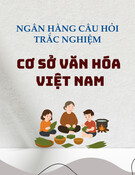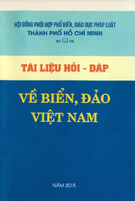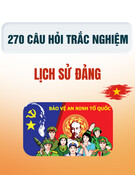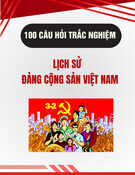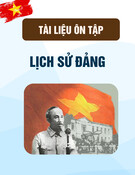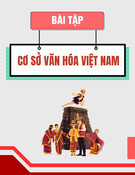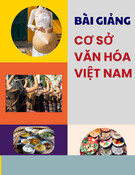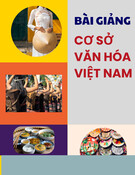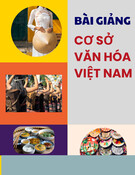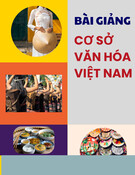
TNU Journal of Science and Technology
230(03): 108 - 117
http://jst.tnu.edu.vn 108 Email: jst@tnu.edu.vn
BAC SON SAFETY ZONE: HISTORY AND PRESENT
Nguyen Thi Hoa*, Do Quynh Nhu
TNU – University of Education
ARTICLE INFO
ABSTRACT
Received:
06/02/2025
According to Decision No. 1714/QĐ-TTg dated September 23, 2013,
and Decision No. 2475/QĐ-TTg dated December 19, 2016, by the
Prime Minister, 10 communes and 1 town in Bac Son district is
recognized as part of the Central Safe Zone in Lang Son province
during the resistance against French colonialism. The main purpose of
this article is to study the history and role of Bac Son from the Bac
Son Uprising (1940) to the end of the resistance against French
colonialism (1954) to clarify why Bac Son was recognized as a
Central Safe Zone. Additionally, the authors clarify the current status
of the Bac Son Safe Zone and discuss issues related to the
preservation and promotion of the historical and cultural values of the
region. Using historical and logical methods as the main approach,
combined with ethnographic fieldwork, synthesis, and analysis
methods, the authors conducted the research to address the research
goals and tasks. The research results show that from the Bac Son
Uprising to the victory of the national resistance against France, the
land and people of Bac Son made significant contributions to the
revolutionary cause of the nation, deserving of being a Central Safe
Zone during the resistance against French colonialism. Today, it is
essential to develop solutions to preserve and promote the values of
the Safe Zone in this region.
Revised:
31/3/2025
Published:
31/3/2025
KEYWORDS
Uprising
Bac Son
Safe zone
National Salvation Army I
Revolution
AN TOÀN KHU BẮC SƠN: LỊCH SỬ VÀ HIỆN TẠI
Nguyễn Thị Hoà*, Đỗ Quỳnh Như
Trường Đại học Sư phạm – ĐH Thái Nguyên
THÔNG TIN BÀI BÁO
TÓM TẮT
Ngày nhận bài:
06/02/2025
Theo quyết định số 1714/QĐ-TTg ngày 23/09/2013 và quyết định số
2475/QĐ-TTg ngày 19/12/2016 Thủ tướng Chính phủ, 10 xã và 1 thị
trấn của huyện Bắc Sơn được công nhận thuộc vùng An toàn khu của
Trung ương ở tỉnh Lạng Sơn trong kháng chiến chống Pháp. Nghiên
cứu lịch sử, vai trò của vùng đất Bắc Sơn từ khởi nghĩa Bắc Sơn
(năm 1940) đến hết kháng chiến chống thực dân Pháp (năm 1954) để
làm rõ giá trị lịch sử - văn hóa, lý do Bắc Sơn được công nhận là An
toàn khu của Trung ương là mục đích nghiên cứu chính của bài báo.
Bên cạnh đó, nhóm tác giả làm rõ hiện trạng An toàn khu Bắc Sơn
hiện nay và bàn luận những vấn đề đặt ra để bảo tồn, phát huy giá trị
lịch sử - văn hóa của vùng đất. Với phương pháp lịch sử, phương
pháp logic là chủ đạo, kết hợp phương pháp điền dã dân tộc học, tổng
hợp, phân tích, nhóm tác giả thực hiện nghiên cứu và giải quyết mục
đích, nhiệm vụ nghiên cứu đề ra. Kết quả nghiên cứu cho thấy từ
khởi nghĩa Bắc Sơn đến thắng lợi kháng chiến toàn quốc chống Pháp,
đất và người Bắc Sơn đã có những đóng góp quan trọng cho sự
nghiệp cách mạng của dân tộc, xứng đáng là An toàn khu của Trung
ương trong kháng chiến chống Pháp và ngày nay cần thiết có các giải
pháp để giữ gìn và phát huy giá trị An toàn khu của vùng đất ấy.
Ngày hoàn thiện:
31/3/2025
Ngày đăng:
31/3/2025
TỪ KHÓA
Khởi nghĩa
Bắc Sơn
An toàn khu
Đội cứu quốc quân I
Cách mạng
DOI: https://doi.org/10.34238/tnu-jst.11984
* Corresponding author. Email: hoant.his@tnue.edu.vn

TNU Journal of Science and Technology
230(03): 108 - 117
http://jst.tnu.edu.vn 109 Email: jst@tnu.edu.vn
1. Introduction
A safe zone is a territorial area possessing comprehensive elements of “geographical
advantage and social harmony”, particularly characterized by a solid revolutionary mass base,
ensuring security for cadres and revolutionary leadership organizations to operate. Established
during the August Revolution of 1945 and the nationwide resistance against French colonialism
(1946 - 1954), safe zones served not only as protective havens for leadership organs and
revolutionary forces but also functioned as sites for implementing Party and State policies [1].
The issue of central safe zones during the anti-French resistance period has generally been
studied by numerous scholars from various perspectives and scales. Tran [2] elucidated the
formation process of the Central Safe Zone in Tuyen Quang and the operational security
measures for the strategic resistance headquarters within this safe zone during the anti-colonial
French resistance. Regarding the role of the Dinh Hoa Safe Zone in the Viet Bac Autumn-Winter
Campaign of 1947, Dang et al. [3] provided a comprehensive overview of the safe zone and its
significance for the Vietnamese revolutionary movement. Addressing the same subject, Nguyen
et al. [4] highlighted the crucial role of the Dinh Hoa Safe Zone within the Viet Bac resistance
base area. Beyond Tuyen Quang and Thai Nguyen, scholars have conducted research on the Bac
Son Safe Zone, addressing to varying degrees its historical formation, role, and current status.
Regarding the Bac Son Uprising (1940) - a historical event intrinsically linked to the Bac Son
region, several studies have elucidated the uprising, its role, and significance for the Vietnamese
revolutionary movement [5], [6]. Additionally, Duong [7] highlighted the role of local ethnic
populations in the Bac Son Uprising, Bui [8] clarified the interconnection between the Bac Son
Uprising and the formation of the Bac Sin – Vo Nhai resistance base. The resistance activities
and base-building efforts in Bac Son – Vo Nhai from July 1941 to February 1942 have also been
the subject of scholarly investigation [9]. Notably, addressing the current status of the Bac Son
Safe Zone, Do et al. [10] presented the tangible heritage associated with the Bac Son Safe Zone,
emphasizing the importance of the Bac Son Uprising historical site.
In general, the history and current status of the Bac Son Safe Zone have been addressed in
research works from diverse perspectives and analytical approaches. However, until now, there
has not been a comprehensive, systematic study on this subject. Therefore, this paper aims to
elucidate the history and role of the Bac Son region from the Bac Son uprising (1940) through the
end of the resistance against French colonialism (1954) to clarify its historical-cultural value and
the rationale for Bac Son’s designation as a Central Committee safe zone. Additionally, the
authors examine the current state of the Bac Son safe zone and discuss the emerging issues
concerning the preservation and promotion of the region's historical and cultural values.
2. Research methods
Based on written material and fieldwork material, the authors primarily employ historical and
logical methodologies. The historical method is utilized to study and present the historical
progression from the Bac Son uprising (1940) to the victory in the resistance against France (1954).
The logical method aims to analyze and evaluate the role and impact of the Bac Son uprising, along
with the land and people of Bac Son, on the Vietnamese revolutionary victory during this period,
thereby confirming the region’s status as a safe zone. Additionally, the authors employ
ethnographic fieldwork methods to conduct on-site research at the present-day Bac Son safe zone,
along with interdisciplinary research methods (statistical analysis, synthesis, analysis, etc.).
3. Results and discussion
3.1. From the Bac Son uprising to the August 1945 Revolutionary Victory
In early 1930, the Communist Party of Vietnam was established with a rigorous organizational
structure and a sound political platform. It assumed sole leadership of the Vietnamese revolution,

TNU Journal of Science and Technology
230(03): 108 - 117
http://jst.tnu.edu.vn 110 Email: jst@tnu.edu.vn
unified the forces and strength of the entire Vietnamese nation, and timely leading the people into
a new period of struggle. The revolutionary surge of 1930 - 1931, culminating in the “Xô viết
Nghệ Tĩnh” movement, demonstrated the extraordinary revolutionary spirit and immense power
of our people. Millions of peasants rose up alongside the working class struggles against
imperialism and feudalism. By late 1931, our country’s revolution entered a period of decline.
However, due to our people’s patriotic spirit, their fervent desire for independence and freedom,
and the loyalty and resolute fighting spirit of cadres and party members, the revolution quickly
emerged from this declining period. It then advanced toward a new surge - the democratic
movement of 1936 - 1939. The Party Central Committee Conference in November 1939 marked
a significant shift in revolutionary direction and methodology. It transitioned from democratic
and livelihood struggles to directly overthrowing the imperialist regime and its collaborators.
Additionally, it moved from legal and semi-legal activities to clandestine, illegal operations and
armed uprising. The conference emphasized that the Party must resolutely focus the masses’
struggles on opposing imperialism and its collaborators.
In June 1940, Nazi Germany captured Paris, forcing the French government to sign a
surrender agreement on June 22, 1940. The French defeat in their homeland weakened the French
colonial administration in Indochina. Exploiting this opportunity, Japanese forces advanced from
Guangxi (China) to occupy Lang Son. Although the French forces there commanded by General
Mennerat were numerous, they had lost fighting spirit, with most surrendering to the Japanese
forces while the remainder fled in panic via the Diem He - Binh Gia - Bac Son route to Thai
Nguyen. The French colonial administration collapsed in many areas, with district chiefs in That
Khe, Diem He, Trang Dinh, Bac Son, and Na Sam either fleeing or being captured [5]. In this
situation, masses in several locations rose up to destroy government offices, punish mandarins,
seize weapons, and resist looting by French stragglers. In Bac Son district, seizing this favorable
opportunity, on September 25, 1940, several party members who had recently escaped from Lang
Son prison (Nong Van Cun, Hoang Dinh Rue...), joined with party members from Bac Son
(Duong Cong Binh, Hoang Van Han...). They decided to mobilize the masses for uprising,
establishing an Uprising Committee and armed self-defense units to initiate the insurrection.
Faced with conditions ripe for an uprising to fight the French and expel the Japanese, on the
evening of September 26, 1940, at Nong Luc village temple (Hung Vu commune), the Hung Vu
commune party cell organized a meeting. The meeting had the direct participation of Bac Son
District Party Committee members, including: Hoang Dinh Rue, Nong Van Cun, and Duong Van
Thuc. Those attending the meeting discussed, analyzed the situation, and determined the
direction and actions for attacking Mo Nhai post and establishing the Uprising Command [7].
At 20:00 on September 27, 1940, after ambushing French soldiers at Canh Tiem pass, the self-
defense forces and over 300 civilians (including some local militia members, canton, and
commune units), equipped with rifles, flintlock guns, spears, and clubs, divided into 3
contingents to attack Mo Nhai post and surround the Bac Son district headquarters. With
overwhelming force, the insurgents quickly achieved victory, taking control of the district
headquarters, forcing District Chief Hoang Van Sy and the soldiers at Mo Nhai post to flee across
Canh Dan pass to Bang Mac. Immediately following the victory, at dawn on September 28, 1940,
the Uprising Committee assembled the masses and organized a rally at the Bac Son district
administrative center, declaring the abolition of the enemy administration, organizing forces to
ensure security, and maintaining activities in the villages. On the same day, people from
neighboring localities such as Hung Vu, Chieu Vu, Nam Nhi, and Trang Son simultaneously rose
up to expel and disarm the defeated French forces. Faced with the rapid growth of the mass
movement and insurgent forces, the Japanese hastily compromised with the French and
facilitated French concentration of forces to suppress the revolution. “On October 1, 1940, the
Binh Gia agent brought 17 indigenous guards to recapture Binh Gia post. Boócdiê - the
commander of Dinh Ca post (Thai Nguyen) mobilized forces to attack the central area of the Bac

TNU Journal of Science and Technology
230(03): 108 - 117
http://jst.tnu.edu.vn 111 Email: jst@tnu.edu.vn
Son uprising. The French colonialists terrorized the population by burning 14 houses in Minh
Dan village, Hung Vu commune” [11, p.112]. Due to disparities in forces and weaponry, the
French colonialists recaptured the district headquarters, re-established administrative apparatus in
Bac Son, and conducted searches, arrests, torture, and executions of uprising participants,
destroying several revolutionary bases and suppressing the uprising.
Although the Bac Son uprising was defeated, it left an immensely significant impact on the
Vietnamese revolution. The gunfire of the Bac Son uprising awakened the revolutionary fighting
spirit of people throughout the country. As the 8th Central Committee Conference accurately
assessed, the Bac Son uprising was “the gunfire signaling the nationwide uprising, marking the
beginning of armed struggle by ethnic groups in an Indochinese country” [12, p.109]. Later,
when discussing the Bac Son uprising, Comrade Truong Chinh remarked that “the Bac Son
uprising will forever be recorded in our nation’s revolutionary history as an exemplar of the
revolutionary heroism of the Vietnamese people” [13].
On October 14, 1940, a public assembly was convened in Vu Lang commune, with over 100
participants. Comrade Tran Dang Ninh officially declared the establishment of the Bac Son
Guerrilla Unit and passionately urged the local population to actively support and continue
intensifying the revolutionary uprising. He meticulously explained the Party’s strategic approach
to combating French colonial forces and expelling Japanese occupation, while articulating the
urgent tasks confronting local Party members and citizens: to organize armed military units,
establish strategic base areas, and engage in guerrilla warfare to resist enemy white terror tactics.
Implementing the directives of the 7th Central Conference (November 1940) regarding the
preservation and cultivation of armed forces during the Bac Son uprising to form the initial
military capital for the revolution. In February 1941, on the way to attend the 8th Central
Conference at Pac Bo (Cao Bang), convened by leader Nguyen Ai Quoc; a Central Party
delegation comprising Comrades Truong Chinh, Hoang Van Thu, Hoang Quoc Viet, and Tran
Dang Ninh paused at Khuoi Noi, Vu Le commune (Bac Son). Here, the Central Committee
members convened with the Bac Son Party Committee and the Bac Son Guerrilla Unit Command
to assess the situation and disseminate the Party’s guidelines. “Comrade Hoang Van Thu, a
member of the Party Central Standing Committee and Secretary of the Northern Regional
Committee, communicated to all cadres and Party members of the Bac Son Party Committee the
Central Committee’s decision to rename the Bac Son Guerrilla Unit as the Bac Son National
Salvation Army” [11, p.129]. Upon its establishment, the unit comprised 32 comrades, with
Comrade Luong Van Tri as the commander. On behalf of the Party Central Committee, Comrade
Hoang Van Thu assigned the Bac Son National Salvation Army the mission: “actively employ
armed operational methods, consolidate and expand guerrilla bases, and rapidly develop forces
comprehensively to be prepared for the opportune moment to initiate an uprising and seize
political power” [11, p.131]. On behalf of the Bac Son National Salvation Army, Comrade
Luong Van Tri pledged to the Party Central Committee and the Northern Regional Committee a
resolute commitment to fulfilling the assigned task.
Following its establishment, the Bac Son National Salvation Army reorganized its squads,
strategically assigning officers and soldiers to specific operational zones while simultaneously
intensifying propaganda and mobilization efforts to develop revolutionary grassroots support and
progressively expand the Bac Son - Vo Nhai base area. At the central base of Khuoi Noi,
temporary shelters were constructed, and training grounds were prepared to continue organizing
military and political training programs. The Bac Son National Salvation Army also launched a
bulletin titled “Guerrilla”, with Comrade Luong Van Tri serving as the chief editor, aimed at
supporting propaganda work during the revolutionary movement’s development and the
establishment of the Bac Son - Vo Nhai base. The platoon simultaneously conducted training and
engaged in military operations designed to protect the revolutionary base and continuously
develop its forces. This represented the inevitable outcome of an energetic revolutionary

TNU Journal of Science and Technology
230(03): 108 - 117
http://jst.tnu.edu.vn 112 Email: jst@tnu.edu.vn
movement, “the guerrilla unit’s operational territory progressively expanded across multiple
communes in Bac Son, including Huu Vinh, Vu Le, and extending to Lau Thuong, Phu Thuong,
Trang Xa, La Hien (Vo Nhai) and Cay Thi (Dong Hy, Thai Nguyen)” [14, p.239].
Following the 8th Central Conference of the Party (May 1941) chaired by leader Nguyen Ai
Quoc at Pac Bo (Cao Bang), Central Party Committee members including Truong Chinh, Hoang
Van Thu, Hoang Quoc Viet, Phung Chi Kien, and other central cadres remained in Bac Son for
42 days to directly guide the revolutionary movement and disseminate the 8th Central Conference
Resolution to Party members of the Bac Son Party Committee and soldiers of the Bac Son
National Salvation Army. However, local reactionary elements became aware of the Central
Committee delegation’s location. French colonial forces intensified their suppression and terror
tactics. “With such forces, the French colonials hoped to accomplish two objectives
simultaneously: capturing leading cadres and the Party’s strategic organs to dissolve the
Communist movement in Indochina, and completely eliminating the National Salvation Army
while suppressing the revolutionary movement in Bac Son” [11, p.152]. The enemy advanced by
establishing fortifications, systematically dividing forests and villages for sweeping operations.
Wherever they progressed, they arrested people, pillaged property, burned houses and farmlands
to intimidate the population. Civilians were forced into concentrated camps surrounded by
towering bamboo fences and guard watchtowers. Strict regulations permitted residents to leave
camps only between 8 AM and 4 PM. The enemy’s insidious strategy of separating the people
from the National Salvation Army posed significant challenges. For an extended period, the Bac
Son population endured extreme hardships, sacrificing personal comfort to shelter and protect
revolutionary cadres. Throughout the Central Committee and Northern Regional Committee’s
revolutionary activities in Bac Son, the locals provided absolute protection, and created optimal
working conditions. Numerous families selflessly assisted revolutionary cadres, ensuring no
personnel were captured or killed during their operations. Upon safely escorting the Central Party
Committee members, “the enemy discovered and implemented white terror against the Bac Son
population. The Mo Pia hamlet (Tan Lap commune) was massacred, while Ban It hamlet (Vu Le
commune) saw 16 households completely destroyed, burned, and killed, with only one child
managing to escape” [15, p.69].
The establishment of the Bac Son National Salvation Army (National Salvation Army I)
marked a critical developmental milestone for the revolutionary movement in Bac Son and the
entire national revolutionary endeavor. It is a foundational premise for the Party’s subsequent
formation of National Salvation Army II and III. The Bac Son National Salvation Army was one
of the first revolutionary armed units organized, educated, and trained by the Party, and
simultaneously constituted one of the primordial units that would eventually evolve into the
contemporary Vietnamese People’s Army. From its inception, the Bac Son National Salvation
Army not only led armed struggle movements in Bac Son but also provided absolute protection
for Central Party Committee and Northern Regional Committee cadres throughout their
operational period. Critically, the unit ensured the complete safety of Party Central Standing
Committee members during their journey to and from the Eighth Central Conference at Pac Bo
(Cao Bang province). Progressing from the initial Mo Nhai post assault during the Bac Son
Uprising, the unit advanced through establishing the Bac Son Guerrilla unit and subsequently
developing the Bac Son - Vo Nhai base area. The unit gradually expanded its operational territory
across seven districts (Bac Son, Vo Nhai, Phu Luong, Dinh Hoa, Dai Tu, Son Duong, Cho Don),
making a substantial contribution to establishing the Party’s first liberated zone prior to the
nationwide August 1945 General Uprising.
3.2. Bac Son during the nationwide resistance against French colonialism (1946 - 1954)
From victory during the August Revolution 1945, the birth of the Democratic Republic of
Vietnam represented a critical turning point in national history. However, the nascent republic


![Chính sách tiếp quản giáo dục Đại học ở miền Nam Việt Nam sau 1975: Từ chỉ đạo đến thực thi [Phân tích chi tiết]](https://cdn.tailieu.vn/images/document/thumbnail/2025/20250804/kimphuong1001/135x160/4571754299722.jpg)








